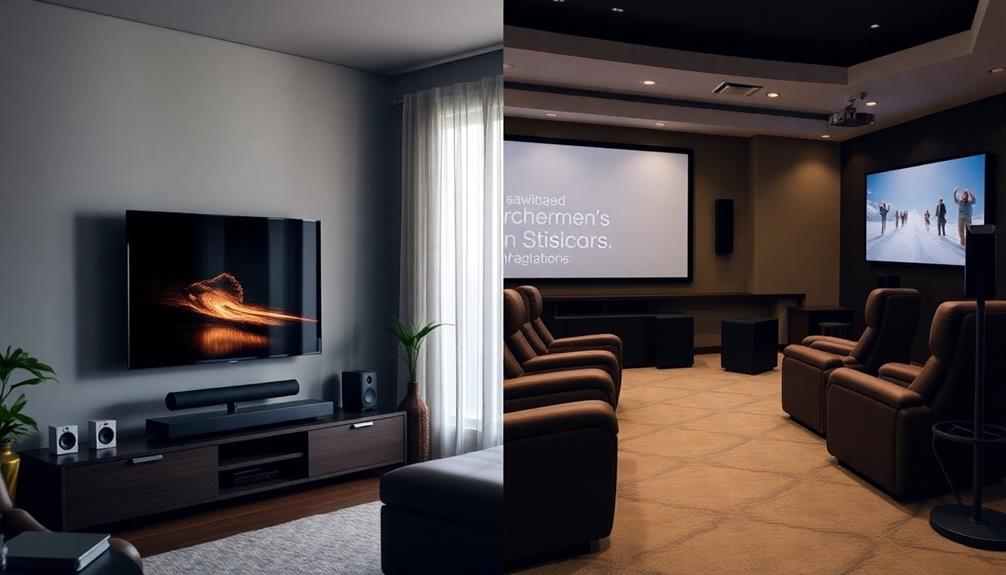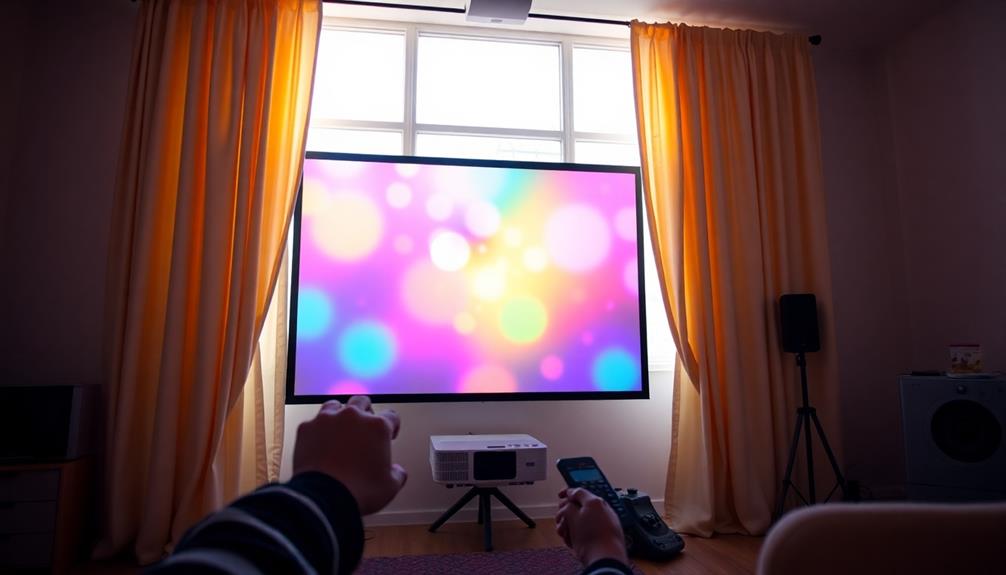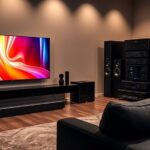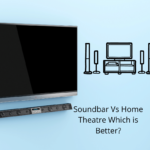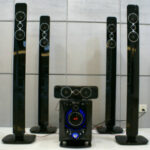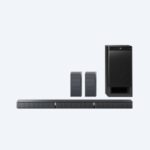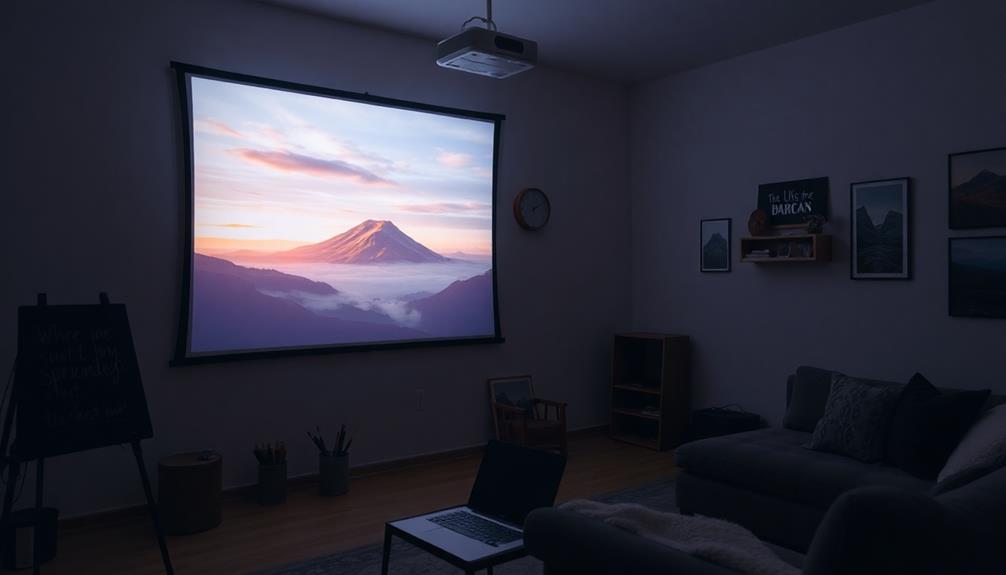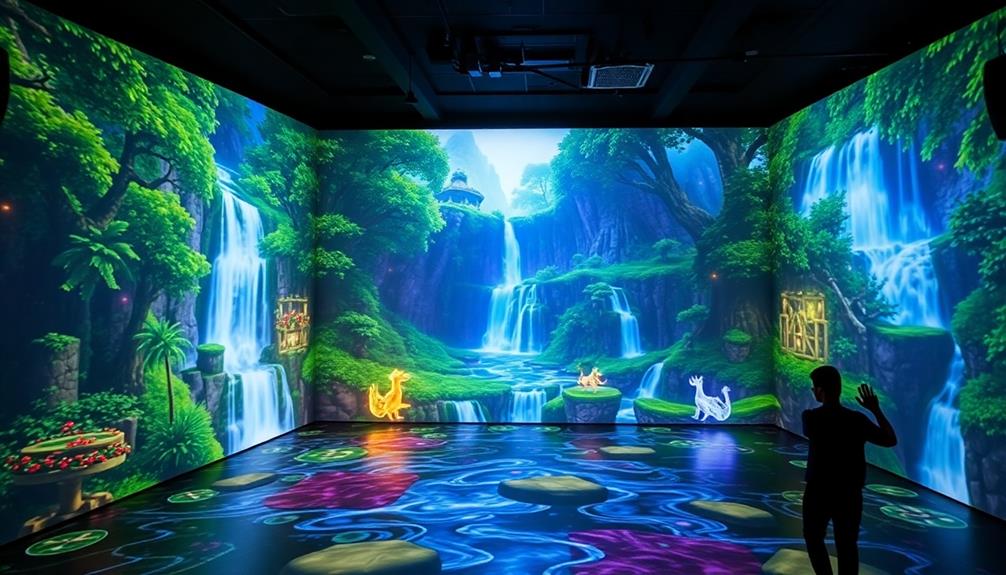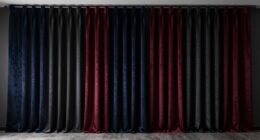When deciding between a soundbar and a home theater system, consider your audio needs, space, and budget. Soundbars are great if you want a compact, affordable solution that enhances your TV's sound for about $100. They're easy to set up and require little space. In contrast, home theater systems offer an immersive experience, ideal for movie lovers and gamers, but they start around $500 and need more setup space and technical know-how. Evaluating your priorities will guide your choice, and there's more to explore about features and options that can meet your unique needs.
Key Takeaways
- Soundbars are budget-friendly, starting around $100, while surround sound systems require a minimum investment of $500 for decent performance.
- If space is limited, soundbars offer a compact design, whereas surround systems need more room for multiple speakers.
- Soundbars are user-friendly with easy installation, while surround systems often require technical skills and complex setups.
- For immersive audio experiences, surround sound systems excel with superior sound quality and dynamic range compared to soundbars.
- Consider your long-term audio needs; soundbars are suitable for casual viewing, while surround systems cater to serious movie enthusiasts and gamers.
Understanding Your Audio Needs
When you're deciding between a soundbar and a home theater system, it's crucial to understand your audio needs. If you typically enjoy casual watching or streaming, a soundbar might suit you perfectly. They deliver decent sound quality without taking up much space, making them ideal for smaller rooms.
However, if you're a serious movie enthusiast or gamer, you'll likely crave the immersive audio experience that a surround sound system provides.
Consider the size of your room; surround sound systems require more space for ideal speaker placement. If you have the room to spare and the desire for a fully immersive setup, investing in a surround sound system could elevate your audio experience greatly.
Also, think about your technical expertise. Soundbars are generally easy to install with minimal setup, while surround sound systems might involve complex wiring and calibration.
Finally, if customization is crucial to you, remember that surround sound systems offer component upgrades, allowing you to tailor your audio experience.
Ultimately, weigh your audio needs against your budget to make an informed choice.
Budget Considerations and Pricing
When you're weighing your options, cost is a key factor in choosing between a soundbar and a home theater system.
Soundbars often offer a more budget-friendly entry point, but investing in a complete surround sound system might provide better long-term value and sound quality.
Consider how much you're willing to spend now versus what you might need later to enhance your audio experience.
Cost Comparison
Cost plays a significant role in choosing between a soundbar and a home theater system. If you're on a tight budget, soundbars are typically the more affordable option, starting around $100. This makes them appealing for users wanting to enhance their audio experience without breaking the bank.
In contrast, basic surround sound systems start at approximately $500, which includes an AV receiver and multiple speakers.
As you consider your options, remember that higher-end soundbars can reach prices near $200. However, if you find yourself spending over $500 on a soundbar, you might start to think about investing in a full surround sound system for that richer audio quality. Complete systems can exceed $1,000, depending on the components you select.
Ultimately, budgeting is essential. Soundbars provide a cost-effective solution for those looking to improve their audio without the complexity and expense of wiring and multiple speakers associated with surround sound systems.
Their popularity stems from this affordability and ease of installation, catering to consumers who prioritize convenience over high-end audio performance.
Value of Upgrades
Upgrading your audio setup can often yield a noticeable improvement in your viewing experience, and this is especially true when evaluating soundbars and home theater systems.
Soundbars usually range from $100 to $200, making them an affordable choice if you want superior sound without breaking the bank. For example, the Roku Streambar at around $118 is an excellent budget option.
However, higher-end models can exceed $500, nudging you toward complete surround systems that provide a richer audio experience but require careful budgeting for additional equipment and installation. It's important to reflect on how these upgrades can impact your overall enjoyment, similar to how tax implications on IRA withdrawals can affect your retirement planning.
If you're using a soundbar buying guide, keep in mind that investing in a quality audio system can greatly enhance your enjoyment.
A system with separate components like AV receivers and speakers starts around $500 but offers a more immersive experience. The Klipsch Cinema 400, priced at $355, sits in the midrange category, delivering superior sound that can leave you reluctant to return to inferior options.
Ultimately, whether you opt for a soundbar or a full surround system, it's crucial to weigh the upfront costs against the potential uplift in your overall viewing experience.
Long-Term Investment Considerations
Maneuvering the long-term investment evaluations for audio systems involves some careful thought about your budget and pricing options.
Soundbars can be a cost-effective choice, ranging from around $100 to $500. They provide a quick audio upgrade that's often better than TV speakers. However, once you start spending over $500, you might want to contemplate investing in separate components like AV receivers and speakers, which can enhance sound quality tremendously.
Additionally, evaluating your overall investment goals can help determine whether a soundbar or home theater system aligns with your financial strategy.
On the other hand, home theater systems typically start at around $500 for basic setups and can exceed $1,000 for complete systems, including multiple speakers and subwoofers. While these surround sound systems deliver superior audio experiences, their upfront costs and complexity can be intimidating for casual users.
Think about your long-term audio goals. Soundbars may serve you well initially, but they mightn't provide the immersive experience you seek over time.
If you prioritize richer audio and plan for future upgrades, investing in a home theater system could be worth the extra expense. Balancing immediate needs with long-term satisfaction is key to making the right choice.
Soundbar Overview and Features
Soundbars are a great choice if you're looking for budget-friendly audio options that don't take up much space.
With their ability to simulate surround sound and enhance dialogue clarity, soundbars can greatly improve your overall viewing experience.
You'll find that many models are easy to install, requiring minimal effort and wiring.
With their compact design and straightforward setup, soundbars can greatly enhance your TV's sound without the hassle of a full home theater system.
If you're considering a more immersive sound experience, exploring options like the role of color accuracy in home cinema projectors can also elevate your home theater setup.
Budget-Friendly Options
If you're looking to enhance your TV audio without breaking the bank, budget-friendly soundbars are an excellent option. Many affordable soundbar systems provide significant boosts in audio quality compared to standard TV speakers. For around $100, you can find several options that improve your home entertainment experience without emptying your wallet.
One standout choice is the Roku Streambar, priced at approximately $118. It delivers impressive sound quality and includes streaming capabilities, making it perfect for those who want a multi-functional device.
If you're willing to invest a bit more, the Klipsch Cinema 400 at $355 offers superior midrange audio, appealing to audiophiles on a budget.
These soundbars often come with user-friendly features like Bluetooth connectivity and HDMI-ARC or optical digital connections, ensuring easy integration with your TV and streaming devices.
Compared to dedicated surround sound systems, soundbars are a cost-effective solution, allowing you to enjoy immersive audio without a hefty investment.
Space Efficiency
For those tight on space, soundbars offer a sleek and compact audio solution. Designed with a space-efficient structure, soundbars come in various styles that easily fit into small rooms or minimalist setups. You can wall-mount them or place them in front of your TV without obstructing the screen, providing flexibility in placement.
Here's a quick comparison of soundbars versus traditional home theater systems regarding space efficiency:
| Feature | Soundbar |
|---|---|
| Size | Compact and slim |
| Placement Options | Wall-mounted or front |
| Additional Speakers | Integrated subwoofers |
Simple Installation Process
There's no denying that a soundbar's installation process is pleasantly straightforward. You can set up a soundbar in no time, as it typically involves a simple plug-and-play installation.
Unlike traditional surround sound systems that require multiple speakers and extensive wiring, a soundbar simplifies your life with just one or two cables, usually connecting to your TV via HDMI-ARC or optical digital cables.
If you want even more convenience, some models, like the Roku Streambar, offer Bluetooth connectivity, allowing you to stream audio from your devices effortlessly. This means you won't have to deal with cumbersome setups or extra equipment.
The compact design of soundbars fits seamlessly into various room layouts, and many are wall-mountable, helping you save space while enjoying enhanced audio.
With a soundbar, you get a self-contained audio solution that minimizes clutter and installation time, giving you more time to enjoy your favorite shows and movies.
Advantages of Soundbars
Soundbars offer an impressive blend of affordability and performance, making them a popular choice for many. If you're looking for an easy way to enhance your audio devices without breaking the bank, a sound bar might be exactly what you need. Here are some key advantages:
| Advantage | Description |
|---|---|
| Affordability | Quality options start around $100, perfect for budgets. |
| Compact Design | Fits in limited spaces and can be wall-mounted. |
| User-Friendly Installation | Simple plug-and-play setup with no complex wiring. |
With soundbars, you'll experience high-quality sound that greatly improves your listening experience compared to standard TV speakers. Many models come with integrated subwoofers and Bluetooth connectivity, offering a complete audio solution in one sleek unit. This simplicity makes it easy for you to connect to various devices while maintaining a minimalist aesthetic. Whether you're enjoying a movie night or binge-watching your favorite show, a sound bar elevates your audio experience without the hassle of a full surround sound system.
Disadvantages of Soundbars
While soundbars offer a sleek, space-saving option, they come with notable drawbacks.
You might find their sound quality lacking, especially if you're after rich bass and detailed audio.
Plus, their size can create placement challenges, and you won't have the flexibility to upgrade individual components like you'd with a full surround sound system.
Limited Sound Quality
When it comes to audio performance, soundbars often fall short of delivering the rich, immersive experience that dedicated home theater systems provide. You might notice that soundbars struggle to match the sound quality and detail offered by surround speakers, especially when it comes to dynamic range and clarity at higher volumes.
Here's a quick comparison of sound quality between soundbars and home theater systems:
| Feature | Soundbars | Home Theater Systems |
|---|---|---|
| Soundstage | Less defined | More expansive |
| Bass Performance | Lacking | Deep, impactful |
| Clarity at High Volumes | Distorted | Clear and detailed |
Due to their limited sound quality, soundbars often fail to create a convincing audio environment. The absence of multiple discrete channels can lead to challenges in sound localization, making it harder to hear dialogue clearly. Additionally, soundbars may not effectively reproduce low-frequency sounds, leaving you wanting regarding bass performance. If you're seeking an audio experience that truly sounds better, a dedicated home theater system is likely the way to go.
Inflexible Component Upgrades
Upgrading your audio experience can be a challenge with soundbars due to their self-contained design. Unlike surround sound systems that allow individual component upgrades like speakers or subwoofers, soundbars require you to replace the entire unit for any improvement.
This inflexibility can hinder your ability to adapt to new technology or personal preferences.
Here are some key limitations of soundbars regarding upgrades:
- You can't upgrade individual components, limiting your options for enhancing sound quality.
- Higher-end soundbars often don't provide significant audio improvements due to their design constraints.
- Compact designs may compromise sound quality, which can affect future upgrades.
- Soundbars don't easily accommodate evolving audio formats.
- For future-proofing your audio system, soundbars may prove inadequate.
If you're serious about optimizing your audio experience, consider the advantages of a surround sound system.
With the ability to adjust and expand your setup, you can create a dynamic audio environment tailored to your needs—something soundbars simply can't offer.
Size and Placement Issues
In tight spaces, soundbars can become an unwelcome addition, often being too large for smaller TVs or rooms. This may obstruct your view or take up valuable space you'd prefer to keep free.
Their design typically limits placement options, as you'll likely install them directly below the TV or mount them on the wall, reducing flexibility in audio staging.
Unlike a home theater system with multiple speakers, a soundbar generally lacks the surround sound effect that provides a more immersive experience, especially in larger spaces.
In rooms with tricky acoustics, the single-unit design of a soundbar may struggle to deliver peak sound quality, affecting clarity and depth.
Additionally, because you can't upgrade individual components in a soundbar, you miss out on the opportunity to enhance your audio experience over time.
If you need adjustments related to size and placement, you're stuck with what you have.
Surround Sound System Overview
A surround sound system delivers an immersive audio experience that can dramatically enhance your home entertainment setup. Unlike soundbars, a surround sound system typically includes multiple speakers, including a subwoofer, to create a full surround sound environment. This setup allows you to enjoy superior sound quality and a more engaging experience while watching movies or playing games.
Key features of a surround sound system include:
- Multiple Speakers: Usually a 5.1 configuration (five speakers plus one subwoofer) for distinct sound localization.
- Advanced Audio Formats: Support for Dolby Atmos and DTS:X, which provide more dynamic soundscapes.
- Optimal Speaker Placement: Proper positioning enhances clarity and immersion during playback.
- Customization: You can upgrade components over time to improve your audio experience.
- 360-Degree Sound: Surround sound systems deliver a complete audio experience that envelops you.
With the right setup, your TV audio can transform into a cinematic experience, making every film and game more thrilling.
Just remember that while surround sound systems require more space and a complex setup, the payoff in audio quality is well worth it.
Advantages of Surround Sound Systems
Surround sound systems offer a range of advantages that can greatly elevate your audio experience. By utilizing multiple speakers, these systems create a true 360-degree audio environment, providing superior sound quality and depth. A typical 5.1 surround sound system consists of five speakers and one subwoofer, bringing an immersive experience that enhances your favorite movies and music.
Here's a quick look at some key benefits:
| Advantage | Description |
|---|---|
| Immersive Audio | Experience sound from all directions, making you feel part of the action. |
| Customizable Setup | Mix and match components to fit your preferences and room acoustics. |
| Powerful Bass | Subwoofers deliver deep, impactful bass that enhances low-frequency performance. |
| High Volume Clarity | Maintain sound clarity at high volumes without distortion. |
| Upgrade Potential | Easily upgrade speakers and receivers as technology advances. |
With these benefits, surround sound systems provide a richer and more engaging audio experience that soundbars simply can't match.
Disadvantages of Surround Sound Systems
While they offer impressive audio experiences, surround sound systems come with several notable disadvantages. First and foremost, the initial cost of a surround sound system can be quite high, often exceeding $500 for basic setups. This makes them less accessible if you're on a budget.
Additionally, these systems require ample physical space for multiple speakers and a subwoofer, which can be challenging in smaller living areas or apartments.
The complexity doesn't stop there. Here are a few key drawbacks to take into account:
- Complex installation: Setting up a surround sound system involves multiple wires and speaker placements.
- Technical skills needed: If you're not tech-savvy, you might find the operational intricacies overwhelming.
- Space requirements: You'll need a dedicated area for all components, which may not fit in smaller homes.
- Ongoing investment: Upgrades or additional components can lead to extra costs over time.
- Calibration efforts: Getting ideal performance may require time-consuming adjustments.
In short, while surround sound systems enhance your audio experience, these disadvantages can make them a less appealing choice for many consumers.
Alternative Audio Solutions
Exploring alternative audio solutions can open up a world of options that cater to different preferences and living situations. If you're looking for better sound quality than standard TV speakers, powered speakers like Klipsch's The Fives, Sevens, and Nines might be your best bet. These speakers excel in various audio setups and provide a richer listening experience.
For serious enthusiasts, an AV receiver paired with individual speakers offers the ultimate customizable audio system. This setup allows you to upgrade components as needed and enjoy new formats like 8K video without replacing everything.
If you want flexibility, consider hybrid audio solutions that blend elements of both soundbars and surround systems, creating versatile viewing experiences.
The rise of portable sound solutions, especially Bluetooth-enabled speakers, is also worth noting. They cater to consumers who prioritize convenience and versatility in audio playback.
Additionally, powered bookshelf speakers are gaining traction over traditional soundbars, thanks to their superior sound quality and placement options.
With so many alternatives available, you're sure to find the right solution that fits your audio needs and lifestyle.
Making Your Decision
When deciding between a soundbar and a home theater system, it's essential to weigh several factors. Your choice will depend on your budget, space, audio preferences, and willingness to tackle setup complexity.
Here are some points to evaluate:
- Budget: Soundbars typically start around $100, while a surround sound system requires at least $500 for a decent setup.
- Space Availability: Soundbars are compact and easily fit in smaller rooms, while surround sound systems need more space for multiple speakers.
- Audio Preferences: If you love immersive sound quality for movies and music, a surround sound system will deliver superior fidelity and depth.
- Future Expansion: Surround sound systems allow for upgrading individual components, unlike soundbars, which are generally self-contained.
- Setup Complexity: Soundbars offer a plug-and-play experience, while surround sound systems may require intricate wiring and calibration.
Ultimately, think about what matters most to you.
If you want simplicity and affordability, soundbars are great.
But if you crave the best audio experience and don't mind the setup complexity, investing in a surround sound system could be worth it.
Frequently Asked Questions
Which Is Better, a Soundbar or a Home Theater?
When deciding which's better, consider your space and needs. If you want simplicity and affordability, a soundbar's great. For immersive audio and superior sound quality, a home theater system's worth the investment in a dedicated area.
Are Sound Bars as Good as Surround Sound Systems?
Soundbars aren't as good as surround sound systems. While they improve audio quality, they lack the immersive experience and depth that multi-speaker setups provide, especially when it comes to bass and dynamic range.
What Are the Advantages of Soundbar Over Home Theater?
As the saying goes, "less is more." Soundbars offer affordability, compact design, and easy setup. You'll enjoy great sound quality and modern features, making them perfect for casual viewers who want a hassle-free audio experience.
Is a Sound Bar Better Than an AV Receiver?
When considering if a soundbar's better than an AV receiver, it depends on your needs. Soundbars offer simplicity and affordability, while AV receivers provide richer sound and customization options for an immersive experience.
Conclusion
When choosing between a soundbar and a home theater system, it's crucial to weigh your audio needs and budget. Did you know that 80% of home theater enthusiasts prefer multi-speaker setups for an immersive experience? If you crave rich, cinematic sound and have the budget, a surround sound system might be your best bet. However, if simplicity and space-saving are your priorities, a soundbar could be the perfect solution. Choose what fits your lifestyle best!
